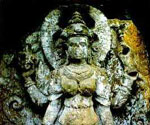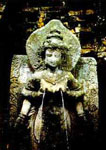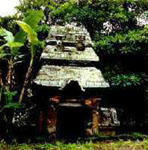BHINNEKA TUNGGAL IKA
The Story of Majapahit Mpu Sindok Airlangga Rajasa Dynasty Joko Dolog Kertanagara Raden Wijaya Shiwa - Budha Gajah MadaTROWULAN
Bajang Ratu Temple Kedaton Temple Tomb of Princess from Champa Tikus Temple Pendopo Agung Trowulan MuseumSiti Inggil GraveyardMAJAPAHIT IN DECLINE
THE TEMPLE OF MAJAPAHIT
Archithectural Style Majapahit's Sites Winginlawang Temple Kidal Temple Singosari Temple Jajaghu Temple Sumberawan Temple Sumberjati Temple Sawentar Temple Rimbi Temple Penataran Temple Tigowangi and Surawana Temple Jabung Temple Mt. Penanggungan Sukuh and Ceto TempleJedong Temple Gentong Temple Kesiman Temple Pasetran Temple Reco LanangGENEALOGY OF THE RAJASA DYNASTY
Airlangga
After spending three or four years in the safety of a forest retreat, Airlangga, as the closest surviving relative to Dharmawangsa, emerged to take over the throne in about 1020. The early part of his reign was spent putting down rebellions and securing the borders of his kingdom. Among his successful military campaigns were those against King Wishnuprabhawa of Wuratan, King Wijaya of Wengker, as well as the subjugation of a powerful queen in the south. In 1032 Airlangga attacked and defeated the ruler of Wurawari, who is believed to have been responsible for the earlier destruction of the old capital of Isana.By the end of Airlangga's reign, in the mid 11th century, the kingdom which he had established is believed to have stretched from Pasuruan in the east, to present day Madiun in the west.
|











 The
famous 'Calcutta Stone', dating from A.D. 1041,
describes a terrible calamity which befell
the East Javanese kingdom of Isana in the early
years of the 11th century. A rebellion incited
by a jealous vassal king resulted in the destruction
of the capital of Watugaluh. The reigning king,
Dharmawangsa, successor to Sri Makutawangsawardhana,
was murdered along with his entire family.
Only the young Airlangga, who was aged about
16 at the time, managed to escape unharmed.
The
famous 'Calcutta Stone', dating from A.D. 1041,
describes a terrible calamity which befell
the East Javanese kingdom of Isana in the early
years of the 11th century. A rebellion incited
by a jealous vassal king resulted in the destruction
of the capital of Watugaluh. The reigning king,
Dharmawangsa, successor to Sri Makutawangsawardhana,
was murdered along with his entire family.
Only the young Airlangga, who was aged about
16 at the time, managed to escape unharmed. Although
there are few surviving archaeological remains
dating from his time, Airlangga is known to have
been a keen patron of the arts, notably literature.
In around 1035, the court poet Mpu Kanwa produced
the Arjuna Wiwaha, which has to this day remained
one of Java's most popular classical stories.
Adapted from the Indian Mahabharata epic, the
poem recounts episodes in the life of the hero
sage Arjuna, who was an incarnation of the Hindu
god Wishnu. There are reasons to believe that
the poem was a portrait of the life of Airlangga
himself.
He, like Arjuna, was seen as a divine
incarnation, apparently laid to rest at Candi
Belahan, where he was portrayed in stone as Wishnu
on Garuda.
Although
there are few surviving archaeological remains
dating from his time, Airlangga is known to have
been a keen patron of the arts, notably literature.
In around 1035, the court poet Mpu Kanwa produced
the Arjuna Wiwaha, which has to this day remained
one of Java's most popular classical stories.
Adapted from the Indian Mahabharata epic, the
poem recounts episodes in the life of the hero
sage Arjuna, who was an incarnation of the Hindu
god Wishnu. There are reasons to believe that
the poem was a portrait of the life of Airlangga
himself.
He, like Arjuna, was seen as a divine
incarnation, apparently laid to rest at Candi
Belahan, where he was portrayed in stone as Wishnu
on Garuda. Towards
the end of his life, Airlangga was faced with
the problem of succession. The rightful heir,
the princess Sanggramawijaya, refused the throne,
preferring to live her life as a hermit. She
is traditionally associated with the legend of
Dewi Kilisuci and the cave of Selomangleng at
Kediri.
Towards
the end of his life, Airlangga was faced with
the problem of succession. The rightful heir,
the princess Sanggramawijaya, refused the throne,
preferring to live her life as a hermit. She
is traditionally associated with the legend of
Dewi Kilisuci and the cave of Selomangleng at
Kediri.